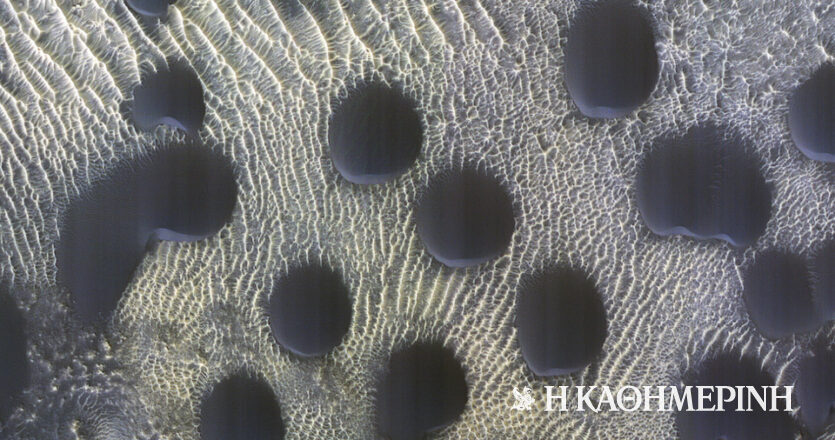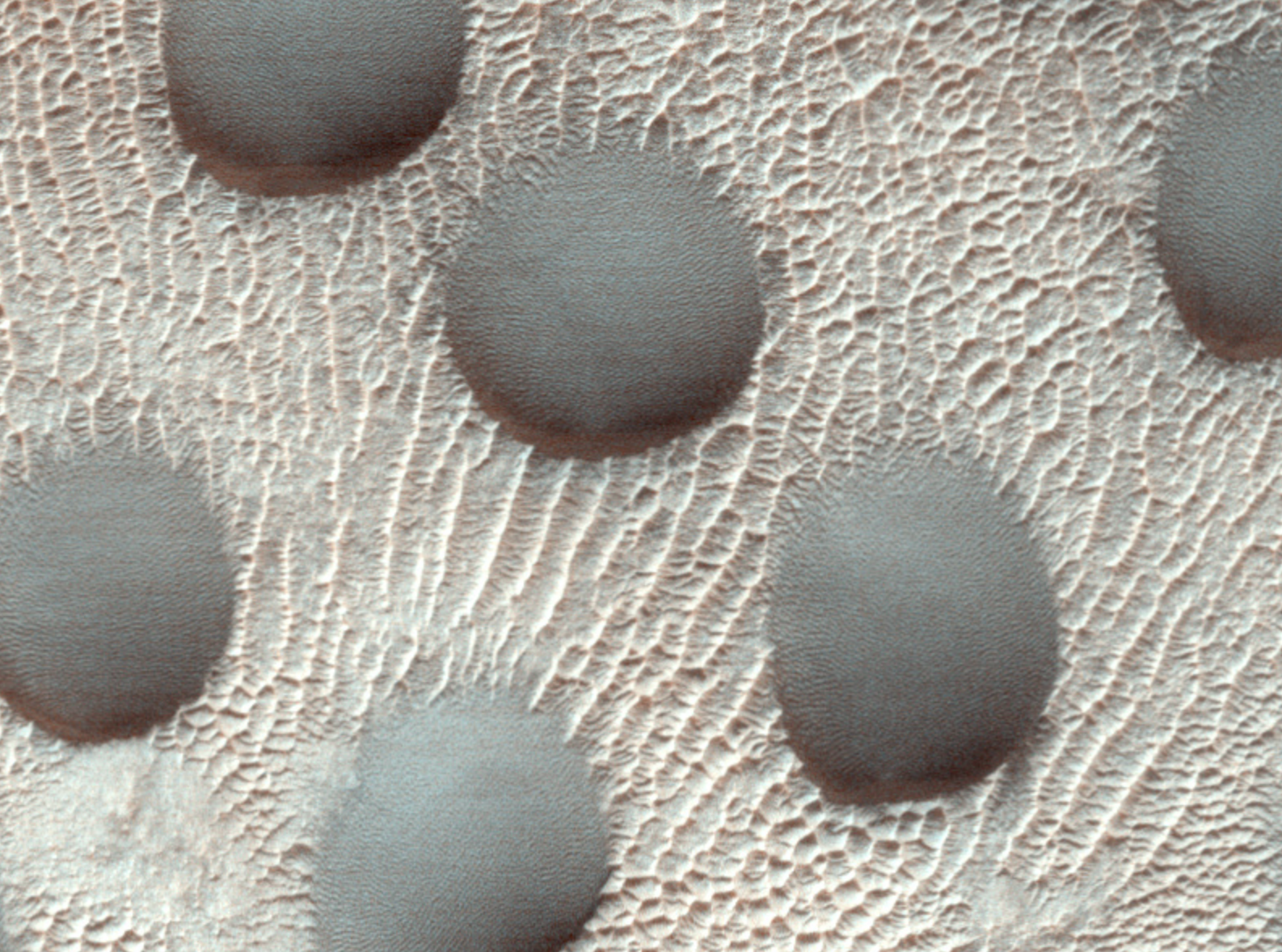
NASA/JPL-Caltech/OR Arizona
An unusual group of sand dunes on Mars was observed by the Mars Reconnaissance Orbiter (MRO), which is flying 300 km above the surface of the Red Planet.
Planetary scientists have observed sand dunes that are almost perfectly round, a rare sight for Mars as dunes tend to be random and irregular in shape.
Its slight asymmetry reveals that its steep sides face south, a subtle imprint of winds blowing in the same direction.
The image was taken with the high-resolution HiRise camera operated by scientists at the University of Arizona.
Using these images, researchers are tracking how ice on Mars is retreating and melting as winter draws to a close. A photo of the same sand dunes taken earlier shows the dunes covered in ice.

It’s just one of 60 sites on Mars being monitored by MRO’s HiRise. The high-resolution camera has been in orbit around the Red Planet since 2006 when MRO reached Mars.
Repeated observations of the sand dunes during the Martian year, which lasts 687 Earth days, allowed planetary scientists to record how fast the dunes were moving. From the equator to the poles, these structures appear to advance by up to 1 meter per Martian year.
On December 21, 2010, the initial MRO mission ended, five years and six months after its launch from Earth on August 12, 2005. This new image shows that even 12 years after the mission ended, the spacecraft and HiRise are still providing valuable data to scientists.
Source: NASA, Space.com
⇒ News of the day
follow her kathimerini.gr on Google News And be the first to know all the news
Find out the latest news from Greece and the world on kathimerini.gr
window.dataLayer = window.dataLayer || [];
function gtag() { dataLayer.push(arguments); }
gtag('js', new Date());
gtag('config', 'G-JJJ7LY7JGM', { 'custom_map': {'dimension3': 'Author'} });
gtag('event', 'author_dimension', {'Author': 'Newsroom'});
}, 0)
// NEW SECOND ANALYTICS setTimeout(function () { (function (d, s, id) { var js, fjs = d.getElementsByTagName(s)[0]; if (d.getElementById(id)) return; js = d.createElement(s); js.id = id; js.async = true; js.src = "https://www.googletagmanager.com/gtag/js?id=UA-112314455-3"; fjs.parentNode.insertBefore(js, fjs); }(document, 'script', 'ga-2'));
window.dataLayer = window.dataLayer || [];
function gtag() { dataLayer.push(arguments); }
gtag('js', new Date()); gtag('config', 'UA-112314455-3');
}, 0) }; document.addEventListener("scroll", NXQuantFuncGTAG);
var NXFbPixel = function () { document.removeEventListener("scroll", NXFbPixel); setTimeout(function () { !function (f, b, e, v, n, t, s) { if (f.fbq) return; n = f.fbq = function () { n.callMethod ? n.callMethod.apply(n, arguments) : n.queue.push(arguments) }; if (!f._fbq) f._fbq = n; n.push = n; n.loaded = !0; n.version = '2.0'; n.queue = []; t = b.createElement(e); t.async = !0; t.src = v; s = b.getElementsByTagName(e)[0]; s.parentNode.insertBefore(t, s) }(window, document, 'script', 'https://connect.facebook.net/en_US/fbevents.js'); fbq('init', '109138906120213'); fbq('track', 'PageView'); }, 0) } document.addEventListener("scroll", NXFbPixel);
var NXTagManager = function () { document.removeEventListener("scroll", NXTagManager); setTimeout(function () { (function(w, d, s, l, i) { w[l] = w[l] || []; w[l].push({ 'gtm.start': new Date().getTime(), event: 'gtm.js' }); var f = d.getElementsByTagName(s)[0], j = d.createElement(s), dl = l != 'dataLayer' ? '&l=" + l : "'; j.async = true; j.src="https://www.googletagmanager.com/gtm.js?id=" + i + dl; f.parentNode.insertBefore(j, f); })(window, document, 'script', 'dataLayer', 'GTM-WWR8QSQ'); }, 0) } document.addEventListener("scroll", NXTagManager);

“Avid problem solver. Extreme social media junkie. Beer buff. Coffee guru. Internet geek. Travel ninja.”





More Stories
Play Age of Mythology: Retold Playtest starting today!
Impressive Maniskin Concert in Greece
What does it mean if we decide not to remove third-party cookies?